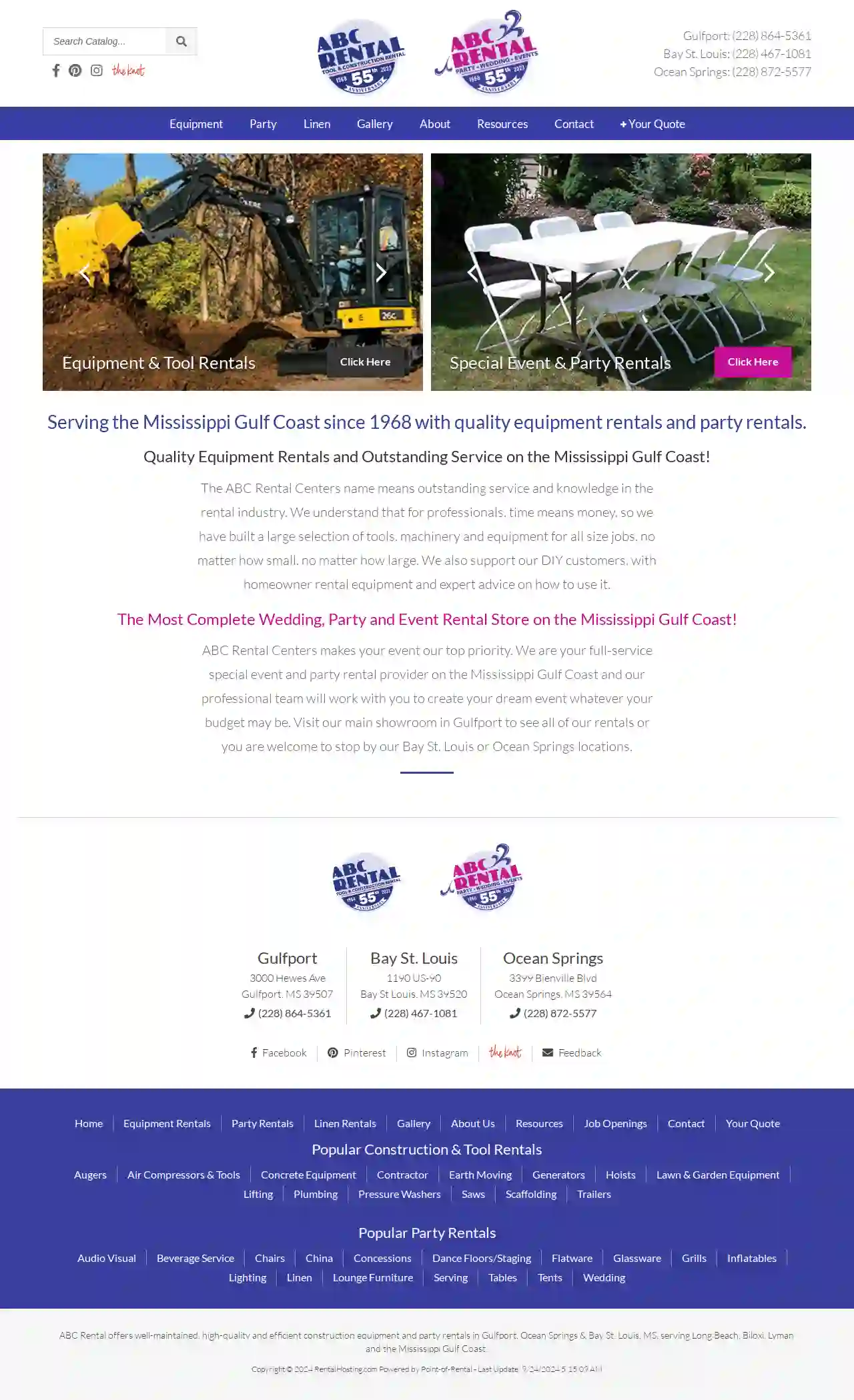Scaffolding Companies Louisville
Find top Scaffolding Company in Louisville
Get 3 FREE Scaffolding Contractors quotes for your project today! Compare profiles, reviews, accreditations, portfolio, etc... and choose the best deal.
Service Needed
City or Town

ABC Rental Center
4.4151 reviews3399 Bienville Blvd, Ocean Springs, 39564, USABC Rental offers well-maintained, high-quality and efficient construction equipment and party rentals in Gulfport, Ocean Springs & Bay St. Louis, MS, serving Long Beach, Biloxi, Lyman and the Mississippi Gulf Coast. With a wide range of equipment and party rentals, ABC Rental is dedicated to providing outstanding service and knowledge in the rental industry.
- Services
- Why Us?
- Gallery
Get Quote- Ma
Magnolia Masonry of South Mississippi LLC
4.914 reviewsGulfport, US- Services
- Why Us?
Get Quote - Th
The Home Depot
4.2Gulfport, US- Services
- Why Us?
Get Quote - Cr
Crom Equipment Rentals Inc
Gulfport, US- Services
- Why Us?
Get Quote - Lo
Lowe's Home Improvement
4.1Gulfport, US- Services
- Why Us?
Get Quote
Over 2,353+ Scaffolding Companies in our network
Our scaffolding experts operate in Louisville & beyond!
ScaffoldingHQ has curated and vetted the Best Scaffolding Companies in Louisville. Find a top & reliable pro today.
Frequently Asked Questions About Scaffolding Companies
Find answers to common questions about scaffolding companies and hiring scaffolding contractors in the USA.
- Traditional and highly versatile.
- Components (tubes, clamps, boards) are assembled on-site.
- Adaptable to complex shapes and structures.
- Requires skilled labor and more time for erection.
- Pre-engineered, modular components.
- Faster and easier to erect.
- Often has higher load capacities.
- May be less versatile for complex shapes.
- Hire Professionals: Just like erection, dismantling should be done by qualified and experienced scaffolding erectors.
- Reverse the Erection Process: The dismantling process should generally follow the reverse order of erection.
- Clear the Area: Ensure the area below is free from people and obstacles.
- Lower Materials Safely: Use ropes or other safe methods to lower dismantled components to the ground.
- Inspect Components: As components are removed, inspect them for damage and store them properly for future use.
- Licensing and Insurance: Verify their licenses are current and that they have adequate insurance coverage.
- Experience: Choose a company with a history of successfully completing similar projects. Ask for references and check their portfolio.
- Safety Record: Inquire about their safety practices and accident history. A strong safety culture is essential.
- Professionalism: Observe their communication, responsiveness, and attention to detail. A reputable company will be organized and transparent.
- Reviews and Testimonials: Read online reviews and feedback from previous clients to assess their reputation.
- Industry Affiliations: Membership in professional organizations like the NASC (National Access & Scaffolding Confederation) indicates a commitment to industry standards.
What is the difference between tube and clamp scaffolding and system scaffolding?
The two main types of scaffolding systems have distinct advantages and disadvantages:
Tube and Clamp Scaffolding:
Tube and Clamp Scaffolding:
What is a scaffolding hoist?
A scaffolding hoist is a mechanical device used to lift materials and equipment vertically up and down scaffolding. It's essential for larger projects where manually carrying heavy items up multiple levels is impractical and unsafe. Scaffolding hoists come in various types and capacities, and their selection depends on the weight and size of the materials being lifted.
How do I dismantle scaffolding safely?
Dismantling scaffolding is just as crucial for safety as erection. Follow these guidelines:
How do I know if a scaffolding company is reputable?
Look for these indicators of a reputable scaffolding company:
What is the difference between tube and clamp scaffolding and system scaffolding?
The two main types of scaffolding systems have distinct advantages and disadvantages:
Tube and Clamp Scaffolding:
Tube and Clamp Scaffolding:
- Traditional and highly versatile.
- Components (tubes, clamps, boards) are assembled on-site.
- Adaptable to complex shapes and structures.
- Requires skilled labor and more time for erection.
- Pre-engineered, modular components.
- Faster and easier to erect.
- Often has higher load capacities.
- May be less versatile for complex shapes.
What is a scaffolding hoist?
A scaffolding hoist is a mechanical device used to lift materials and equipment vertically up and down scaffolding. It's essential for larger projects where manually carrying heavy items up multiple levels is impractical and unsafe. Scaffolding hoists come in various types and capacities, and their selection depends on the weight and size of the materials being lifted.
How do I dismantle scaffolding safely?
Dismantling scaffolding is just as crucial for safety as erection. Follow these guidelines:
- Hire Professionals: Just like erection, dismantling should be done by qualified and experienced scaffolding erectors.
- Reverse the Erection Process: The dismantling process should generally follow the reverse order of erection.
- Clear the Area: Ensure the area below is free from people and obstacles.
- Lower Materials Safely: Use ropes or other safe methods to lower dismantled components to the ground.
- Inspect Components: As components are removed, inspect them for damage and store them properly for future use.
How do I know if a scaffolding company is reputable?
Look for these indicators of a reputable scaffolding company:
- Licensing and Insurance: Verify their licenses are current and that they have adequate insurance coverage.
- Experience: Choose a company with a history of successfully completing similar projects. Ask for references and check their portfolio.
- Safety Record: Inquire about their safety practices and accident history. A strong safety culture is essential.
- Professionalism: Observe their communication, responsiveness, and attention to detail. A reputable company will be organized and transparent.
- Reviews and Testimonials: Read online reviews and feedback from previous clients to assess their reputation.
- Industry Affiliations: Membership in professional organizations like the NASC (National Access & Scaffolding Confederation) indicates a commitment to industry standards.